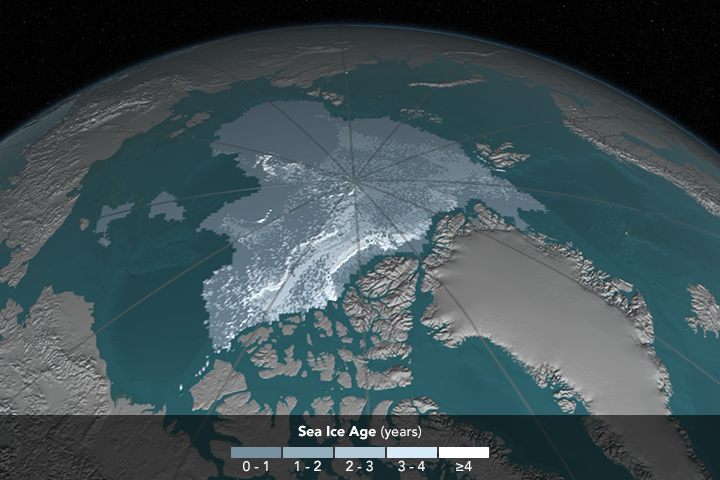

The extent of Arctic sea ice, the vast sheath of frozen seawater that floats on the Arctic Ocean, has been shrinking steadily. But, NASA scientists report, there is an additional problem: As the ice extent has shrunk, the oldest and thickest ice has either thinned or melted away, leaving the sea ice cap more vulnerable to the warming ocean and atmosphere.
In recent years, that old ice – known as perennial sea ice – has declined rapidly. Perennial sea ice, also known as multi-year ice, is the portion of the sea ice that survives the summer melt season. Perennial ice, which might have a life-span of 9 years or more, is the thickest component of the sea ice. Perennial ice can grow up to 4 meters (13.12 feet) thick, in contrast to ice that grows during a single winter, which is about 2 meters (6.6 feet) thick at most.
Walt Meier is a sea ice researcher at NASA’s Goddard Space Flight Center. Meier said in a statement:
What we’ve seen over the years is that the older ice is disappearing. This older, thicker ice is like the bulwark of sea ice: a warm summer will melt all the young, thin ice away but it can’t completely get rid of the older ice. That bulwark is not as good as it used to be. The older ice is becoming weaker because there is less of it, and the remaining ice is more broken up and thinner.
The animation above shows Arctic sea ice for the past three decades -growing and shrinking, spinning, melting in place, and drifting out of the Arctic. The age of the ice is represented in shades of blue-gray to white, with the brightest whites representing the oldest ice.
In September 1984, there were 1.86 million square kilometers (1.16 million square miles) of ice 5+ years old spread across the Arctic at its yearly minimum extent. In September 2016, there were only 110,000 square kilometers (68,350 square miles) of older sea ice left. Meier said:
We have lost most of the older ice: In the 1980s, multi-year ice made up 20 percent of the sea ice cover; now it’s only about 3 percent. The older ice was like the insurance policy of the Arctic sea ice pack. As we lose it, the likelihood for a largely ice-free summer in the Arctic increases.
The animation shows two main bursts of old ice loss. According to NASA, the reason for the first one, which started in 1989 and lasted a few years, was a switch in the Arctic Oscillation – a climate pattern characterized by winds circulating counterclockwise around the Arctic, which resulted in more sea ice getting flushed out of the Arctic than usual.
The second surge in ice loss started in the mid-2000s. Meier said:
What’s happening now is that more old ice is melting within the Arctic Ocean during the summertime. One of the reasons is that the multi-year ice used to be a pretty consolidated ice pack, and now we’re seeing relatively smaller chunks of old ice interspersed with younger ice. These isolated floes of thicker ice are much easier to melt.
The animation and images above are based on data from drifting buoys, weather stations, computer models, and 12 satellites (mostly passive microwave instruments) that have made measurements over the past four decades.
You can learn more about sea ice from NASA’s sea ice fact sheet.
Bottom line: Perennial Arctic sea ice – ice that survives the summer melt – has been rapidly declining. Satellite images show the difference between 1984 and 2016.











